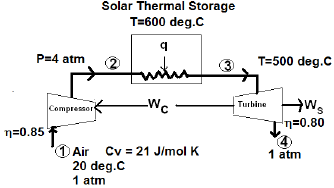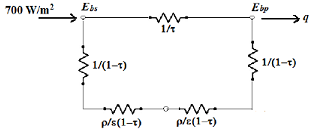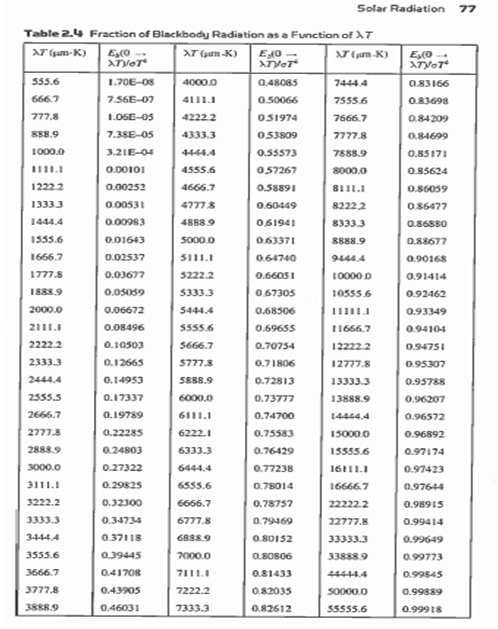Reference no: EM13990193
Q1: Finish the thermodynamic analysis of the hot air power system we looked at in Class, given by

Cp - Cv = R, the ideal gas constant = 8.3 J/mol K. To = temperature of the surroundings = 293 K. Assume work done by a system is positive. Use absolute temperatures where needed and proceed as follows:
- Find Wc, the work of compression. Need T2 - the temperature at point 2. For R&A compression we can find T2 from
ΔS = Cp ln(T2 /T1) + R ln(P1 /P2) = 0
Then we can find for compression Wideal = - (ΔH) (for constant S) = - Cp (T2 - T1)
Now find Wc from the efficiency η that is given in the diagram for R&A compression, in J/mol of air.
- Next we do a similar analysis for the turbine. Find T4 for R&A expansion. Then find Wideal as above, then W of the turbine. Find the net output work Ws from the difference between compression and turbine work in J/mol of air.
Next we compute thermodynamic losses.
- Need T2 for adiabatic (not R&A) compression. From 1st law ΔH = Q - Wc = - Wc = - Cp (T2 - T1) for adiabatic compression
Using Wc from above, find T2, then find ΔS = Cp ln(T2 /T1) + R ln(P1 /P2) for adiabatic compression. Then find Wlost = To ΔS for adiabatic compression
- Find T4 for adiabatic expansion in the turbine. Then make a similar analysis as for the compression to find ΔS for adiabatic expansion in the turbine. Then find Wlost = To ΔS for adiabatic expansion
- Find Wlost in the storage unit. Heat transfer to the air q = - Cp (T3 - T2) using T2 for adiabatic compression. Then we have ΔS for the storage unit = - q/T of the storage unit. ΔS for the air in the storage unit = Cp ln(T3 /T2)
Total ΔS = ΔS for the storage unit + ΔS for the air Then Wlost in the storage unit = To*(total ΔS)
Make a table that summarizes your results.
|
J/mol of air |
% of Wideal |
| Ws net |
|
|
| Wlost in Compressor |
|
|
| Wlost in Turbine |
|
|
| Wlost in Storage Unit |
|
|
| Total Ideal Work |
|
100%
|
So in this manner, we evaluate the thermodynamic efficiency of the net turbine work Ws as a percent of Wideal.
Question: What happens to the thermodynamic efficiency Ws/(Total Ideal Work) when the temperature of the air out of the storage bed increases? Why is that?
Q2: A black flat plate solar collector has a glass cover with ε=0.1, ρ=0, τ=0.9 for λ≤2.5 μm, ε=0.95, ρ=0.05, τ=0 for λ>2.5 μm. Diffuse solar flux = 700 W/m2 hits the collector, calculate the temperature of plate, surroundings at 35 deg. C.
We have the equivalent resistance network

where the radiation properties ε, ρ, τ refer to the glass. This says that part of the solar flux is transmitted through the glass and part of it is reflected by the glass back on to the plate. Ebp and Ebs are the blackbody radiation values of the plate and the surroundings.
We solve the problem in two wavelength bands: for λ ≤ 2.5 microns, and for λ > 2.5 microns.
a) Calculate the equivalent resistances of the network, Req, for each of the wavelength bands. So you have 2 values of Req. (Add the resistances in series and parallel.) If τ = 0, the resistance is infinite for those wavelengths.
b) We have two energy balances for the two wavelength bands. 700 - q = σ [ f1(Tp)4 - f2(Ts)4]/Req for λ ≤ 2.5 microns q = σ [(1-f1)(Tp)4 - (1- f2)(Ts)4]/Req for λ > 2.5 microns
where f1 and f2 are the fractions of the blackbody radiation of the plate Ebp and the surroundings Ebs in the wavelength band λ ≤ 2.5 microns at temperatures Tp and Ts respectively. The heat q is the radiation exchange between the plate and the surroundings for wavelengths greater than 2.5 microns. These equations apply only to absolute temperatures.
c) We know Ts, but we don't know Tp. We can solve the two equations for q and Tp with the aid of Table 2.4 in your book as follows: Calculate λTs for λ = 2.5 microns, and look up f2 in the table. (We see that f2 can be neglected.) Guess Tp, calculate, λTp, look up f1 in the table, calculate q from the second equation, the go back and check if the first equation is satisfied. Or combine the two equations. Repeat until you have a consistent value of Tp that satisfies the equations. Do the best you can interpolating in the table for the fractions f, or look up improved radiation tables on the internet.
This problem shows the difficulties of calculating the heat flow with the presence of the glass plate medium, but if we set up the problem correctly it can be solved.

Q3: Text problem 2.6, except do this for College Park, MD. (Look up latitude and longitude, use Table 2.1 to get the day number.)
2.6 Calculate the solar zeinth and azimuth angles, the sunrise and sunset times, and the day length for Cairo, Egypt, at 10:30 am solar time on April 10.
| Table 2 Day Number and Recommended Average Day for Each Month |
| Month |
Day number |
Average day of the month |
|
|
Date |
N |
δ(deg.) |
| January |
i |
17 |
17 |
-20.92 |
| February |
3l + i |
16 |
47 |
-12 95 |
| March |
59 + i |
16 |
75 |
-2.42 |
| April |
90 + i |
15 |
105 |
9.41 |
| May |
120 + i |
15 |
135 |
18.79 |
| June |
151 + i |
11 |
161 |
23.09 |
| July |
181 + i |
17 |
198 |
21.18 |
| August |
212 + i |
16 |
228 |
13.45 |
| September |
243 + i |
15 |
258 |
2.22 |
| October |
273 + i |
15 |
258 |
-9.60 |
| November |
304 + i |
14 |
318 |
-19.91 |
| December |
114 + i |
10 |
344 |
-23.05 |
Q4: Text problem 2.25, except the monthly average of daily solar radiation is 7 and not 17 MJ/m2/day. (Misprint in text.) Berlin is 52.5 deg. N latitude, use Table 2.5 to get the extraterrestrial solar radiation on a horizontal surface. Find the declination on October 15 (N=288) and calculate the sunset hour angle from eqn.(2.15). Use eqn 2-105b), eqn (1.108), then eqn (2.107). Then the average daily radiation is the product of the average R and the average H.
2.25 A collector located in Berlin, Germany is tilted at 50o and receives a monthly average daily total radiation H equal to 17 MJ/m2-day.
Determine the monthly mean beam and total radiation tilt factors for October for an area where the ground reflectance is 0.2. Also estimate the monthly average daily total solar radiation on the surface.